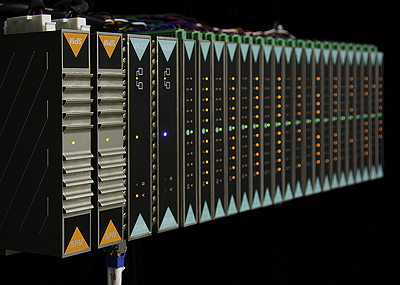The company says that the controller is so powerful that it can run almost any application, independent of size or control task. It can handle discrete, batch, continuous, or multivariable control, and support from tens to thousands of I/O points. Separate PLCs and distributed control systems are no longer needed.
“Starting from a blank sheet of paper, while inventing and deploying advanced semiconductor, mechanical design, cyber-computing and communication technologies, has resulted in a completely new automation platform,” says the company’s chief technology officer and vice-president of engineering, Albert Rooyakkers.
The pin-less backplane carries I/O, power and communications signals. It uses a parallel architecture that supports ultra-fast scan times, regardless of the number of I/Os. The absence of I/O pins is said to improve reliability and cyber-security, while creating a galvanic isolation barrier for every I/O channel. It also allows I/O modules to be installed in any orientation and location, for “unprecedented” flexibility in terms of I/O and cable management.
Secure I/O modules deliver software-defined I/O for analogue, discrete, Ethernet and fieldbus signals. A secure power module is coupled to the backplane to deliver single- and dual-redundant cyber-secure power to the control system.
“As cyber-threats to all industries grow, traditional control system vendors respond by adding cost and complexity to their legacy technology,” says Bedrock’s president, Bob Honor, adding that “unburdened by legacy”, his company has not only created the most cyber-secure system available, “but we have also established new benchmarks for performance, scalability and affordability”.
The electromagnetic backplane is one of several layers of cyber-security protection in the new control system. Others include:
• a real-time operating system (RTOS) claimed to have the highest safety (SIL 4) and security (EAL6+) rating of any available RTOS;
• cyber-secure microcontrollers with encrypted keys and TRNG embedded in all modules including the controller, power supply and I/O;

Bedrock Automation says that its new control system will cut costs and reduce the risk of cyber-attacks
• encasing the modules in anti-tamper metal that is impenetrable without metal-cutting tools; and
• authentication that extends throughout the supply chain, including third-party software and applications
Adding these layers to a conventional DCS, Scada, RTU, PAC or PLC would add cost and complexity and degrade performance, says Bedrock. With the new system, they have been built in from the start.
Bedrock is offering a development environment based on IEC 1131, that supports embedded OPC UA. It will allow users to develop, operate and authenticate control for a variety of PLC, Scada and DCS applications. The software-configurable I/O can be changed in the field with the click of a mouse.
Bedrock says that the controller uses 90% fewer I/O module types than usual, reducing the number of spare parts needed. The reduced component count also cuts the number of panel layouts and wiring diagrams needed. This helps to cut engineering design costs by up to 33%.
Prices for the Bedrock control system start at US$20,000.

